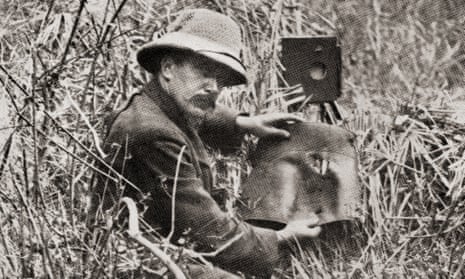I found Mr Cherry Kearton, who has just returned from crossing Africa with a kinema camera for the third time, in the private room of his London office (writes a representative of the Manchester Guardian).
He was endeavouring to conduct a business conversation on the telephone. Round him stood half a dozen merry friends, whose joy at welcoming him home was so ebullient that they refused to be serious. The author of several standard books was giving lifelike imitations of a roaring lion, while the others were laughing loudly at his performance.
Mr Kearton greeted me in an accent that suggested his north-country origin (he hails from Yorkshire). “Come into the other room,” he said, “there are too many wild animals about here; it’s worse than Africa.”
When we were out of “danger” Mr Kearton gave me the following account of his experiences in his last great adventure:
“On the 24th of April 1913, I left England, with the object of traversing Africa from east to west and securing unique kinematograph pictures of animals and native life. It was my third journey of this kind to the dark continent, but this time I wanted to obtain films of wild animals unmolested and unharassed in their native wilds, and not pictures of stage-managed hunts and ‘drives’, The expedition which left Nairobi consisted of two other white men besides myself, including my partner Mr Barnes, who like his namesake in fiction came from New York. We travelled a ‘safari’ or caravan of a hundred porters and bearers.
“After leaving Nairobi, where by the way there are a couple of good modern picture theatres, we struck up north into Abyssinia, going some 300 miles out of our way to avoid the heavy rains. We passed through British east Africa, Uganda, the Belgian and French Congos, and through native territory where for months we saw no white faces save our own. It was nearly a year after the start that we emerged on the west coast, at Basoko, in the Belgian Congo, with 16,000-17,000ft of film to show for our pains.
“During the whole expedition we saw 12 lions, at one time coming across five together. But I could only get close enough to film two. We got within 30ft of a huge rhinoceros, and under cover of my friends’ rifles I secured a splendid film of the brute, who, after glaring savagely at us, decided to give the camera “best”, and waddled away. On another occasion I was lucky enough to get a close-view picture of 12 giraffes nibbling the treetops. For pictures of this nature, I often had to remain in one position for 35 or 40 minutes – dreadfully uncomfortable in a hot fly-pestered country but the slightest movement would have frightened my subjects away.
An encore refused
“Some of my best films are of elephants and crocodiles. With regard to the former animals, Mr Barnes was unkind enough to have a most exciting adventure just when I was out of the way with my camera. While out hunting he got into the midst of a large herd of the brutes, and, after shooting two in self-defence, narrowly escaped with his life. I suggested that we should follow up the herd and that he should try and repeat the performance, explaining what a magnificent film it would make, but, though he’s quite an old friend of mine, he did not seem at all enthusiastic about the idea.
“In Uganda we were made welcome by the kabaka, or ruling chief, a nice, cultured youth, educated by an English tutor. He has a kinematograph camera of his own, and we developed some of his films for him. He possesses, too, his own little picture theatre, and here, thousands of miles away from civilisation, he screens films of English, French, and American life, which he purchased during his foreign travels.
“In the Congo we followed Stanley’s old route and met many of his former followers. Sleeping sickness has terribly ravaged this country, and it is no exaggeration to say that half the population who existed in Stanley’s time have been slain by it.
“The first batch of my films will, I expect, be ready for showing in a few weeks’ time. It is our intention by the way to present to the principal museums of the world a duplicate set of my nature studies. The American Museum of Natural History in New York and the Congo Museum in Brussels will show these films in their lecture halls free to the public.”
Obituary: Cherry Kearton
30 September 1940
The death is announced of Mr Cherry Kearton, naturalist, author, and one of the earliest photographers of wildlife. He was born at Thwaite, in Swaledale, Yorkshire, of a farming family, and from boyhood shared with his elder brother, Richard, the naturalist, a love of animal life.
Richard was the closer student, but Cherry evolved an entirely original idea, that of taking photographs of animals in surroundings which are not seen by every observer –the private life of the animal world. The work demanded almost unlimited patience and remarkable ingenuity in concealment, but the brothers succeeded, and produced the first books on natural history illustrated throughout with photographs.
In later years Cherry practised these methods in central Africa and other foreign lands and photographed big game. In this he was no less successful than he had been in Yorkshire, securing in the course of several years a unique series of photographs showing lions, rhinoceroses, baboons, pythons, buffaloes, and even such small creatures as white ants and locusts leading their normal lives in the wild.
In later years he had made several films, which had a large success. It was one of his boasts that he never used a gun against an animal except in self-defence.
